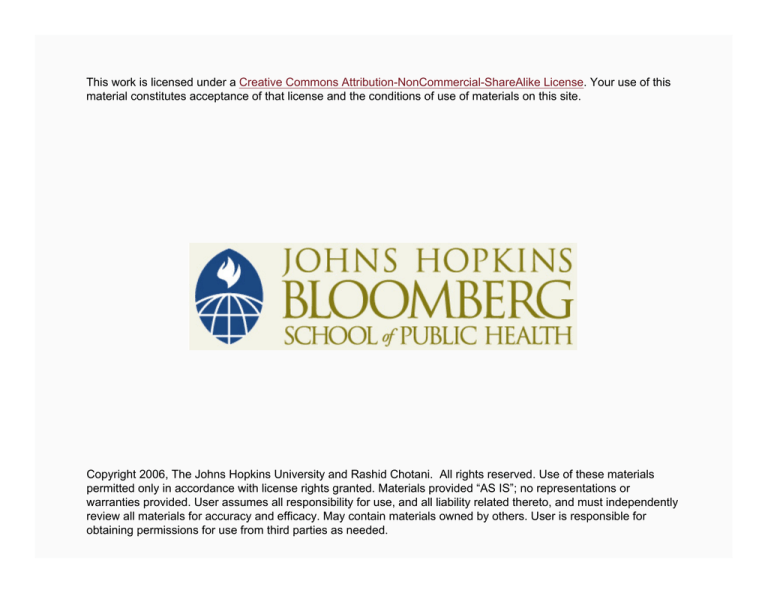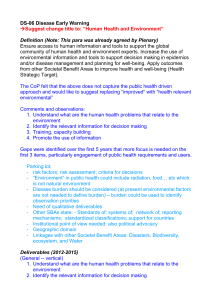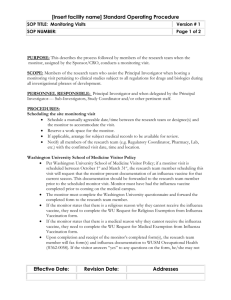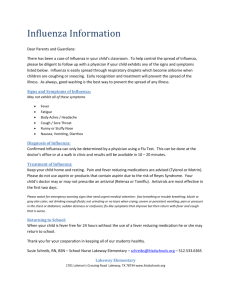
This work is licensed under a Creative Commons Attribution-NonCommercial-ShareAlike License. Your use of this
material constitutes acceptance of that license and the conditions of use of materials on this site.
Copyright 2006, The Johns Hopkins University and Rashid Chotani. All rights reserved. Use of these materials
permitted only in accordance with license rights granted. Materials provided “AS IS”; no representations or
warranties provided. User assumes all responsibility for use, and all liability related thereto, and must independently
review all materials for accuracy and efficacy. May contain materials owned by others. User is responsible for
obtaining permissions for use from third parties as needed.
The Impact of Pandemic Influenza on Public Health
Rashid A. Chotani, MD, MPH
Director, Global Infectious Disease Surveillance and Alert System
Johns Hopkins University
Part One of Six
Basics
Influenza Virus
RNA, enveloped
Viral family—orthomyxoviridae
Size—80-200nm or .08 – 0.12 μm (micron) in diameter
Three types
− A, B, C
Surface antigens
− H (haemaglutinin)
− N (neuraminidase)
Source: CDC Public Health Image Library
4
Influenza Virion
5
Natural Hosts of Influenza Viruses
6
The Burden of Influenza
Seasonal influenza
− Globally—250,000 to 500,000 deaths per year
− In the U.S. (per year)
X ~35,000 deaths
X >200,000 hospitalizations
X $37.5 billion in economic cost (influenza and
pneumonia)
Pandemic influenza
− An ever present threat
7
Contagiousness
Influenza is a highly contagious disease
Typical incubation is two days (range one to four days)
Individuals are contagious for one to four days before the
onset of symptoms and about five days after the first
symptoms
− Peak viral shedding—first three days of illness
Subsides usually by fifth to seventh day in adults
− Can be ten or more days in children
Approximately 50% of infected people do not present any
symptoms but are still contagious
8
Spread of Influenza
Most human influenza infections are spread by virus-laden
respiratory droplets that are expelled during coughing and
sneezing
Influenza viruses range in size from 0.08 to 0.12μm
They are carried in respiratory secretions as small-particle
aerosols (particle sized <10μm)
Sneezing generates particles of varying sizes
− 10-100μm
Photo by AnA oMeLeTe via flickr. Some rights reserved.
9
Modes of Transmission
The three modes of transmission include the following:
− Droplet transmission
− Airborne transmission, and
− Contact transmission
10
Droplet Transmission
Droplet transmission occurs when contagious droplets
produced by the infected host through coughing or sneezing
are propelled a short distance and come into contact with
another person’s . . .
− Conjunctiva
− Mouth
− Nasal mucosa
11
Airborne Transmission
Airborne transmission occurs when viruses travel on dust
particles or on small respiratory droplets that may become
aerosolized when people sneeze, cough, laugh, or exhale
− They can be suspended in the air like invisible smoke
− They can travel on air currents over considerable
distances
− With airborne transmission, direct contact with someone
who is infected is not necessary to become ill
12
Contact Transmission
Two types
− Direct—involves body-to-body surface contact
− Indirect—occurs via contact with contaminated
intermediate objects, such as contaminated hands, or
inanimate objects (fomites), such as countertops, door
knobs, telephones, towels, money, clothing, dishes,
books, needles, etc.
13
Survival of Influenza Virus on Surfaces
With humidity 35%-40%, temperature 28C (82F)
Hard non-porous surfaces—24-48 hours
− Plastic, stainless steel
X Recoverable for more than 24 hours
X Transferable to hands up to 24 hours
Cloth, paper, and tissue
− Recoverable for eight to twelve hours
− Transferable to hands for 15 minutes
Viable on hands less than five minutes only at high viral titers
− Potential for indirect contact transmission
14
Humidity’s Affects on Infectivity Influenza
Adapted from: Loosli, et al. (1943)
15
Particle Inhalation
16
Particle Inhalation
17
Particle Inhalation
18
Definitions
Epidemic—a located cluster of cases
Pandemic—worldwide epidemic
Antigenic drift
− Changes in proteins by genetic point mutation and
selection
− Ongoing and basis for change in vaccine each year
Antigenic shift
− Changes in proteins through genetic re-assortment
− Produces different viruses not covered by annual vaccine
19
Re-Assortment (in Humans)
Migratory
water birds
Domestic birds
Source: WHO/WPRO
20
Re-Assortment (in Pigs)
Migratory
water birds
Source: WHO/WPRO
21
Mutation (in Humans)
Migratory
water birds
Domestic birds
Source: WHO/WPRO
22
From Birds to Humans
Hong Kong, SAR China, 1997, H5N1
Hong Kong, SAR China, 1999, H9N2
The Netherlands, 2003, H7N7
Hong Kong, SAR China, 2003, H5N1
Migratory
water birds
Source: WHO/WPRO
Domestic birds
23





